Population Growth and Regulation
1/26
There's no tags or description
Looks like no tags are added yet.
Name | Mastery | Learn | Test | Matching | Spaced |
|---|
No study sessions yet.
27 Terms
Ideal Conditions
Populations can grow rapidly
Growth Rate
In a population, the number of new individuals that are produced in a given amount of time minus the number of individuals that die
Pop size = births – deaths (+ immigration – emigration)
Intrinsic Growth Rate (r)
The highest possible per capita growth rate for a population
Maximum physiologically possible growth rate for a species under ideal conditions
Exponential Growth Model
Model of population growth in which the population increases continuously at an exponential rate
Assumes ideal conditions
Assumes continuous reproduction- smoother
Nt = N0ert
N = population size
Nt = pop size at time t
N0 = current pop size
e = constant (base of natural log)
r = growth rate (usually per capita)
Geometric Growth Model
Model of population growth that compares population sizes at regular time intervals
Assumes ideal conditions
Assumes there are reproductive seasons- bumpier
Nt = N0λt
N = population size
Nt = pop size at time t
λ = lambda = growth rate
λ = Nx / Nx-1
Exponential vs Geometric Growth Models
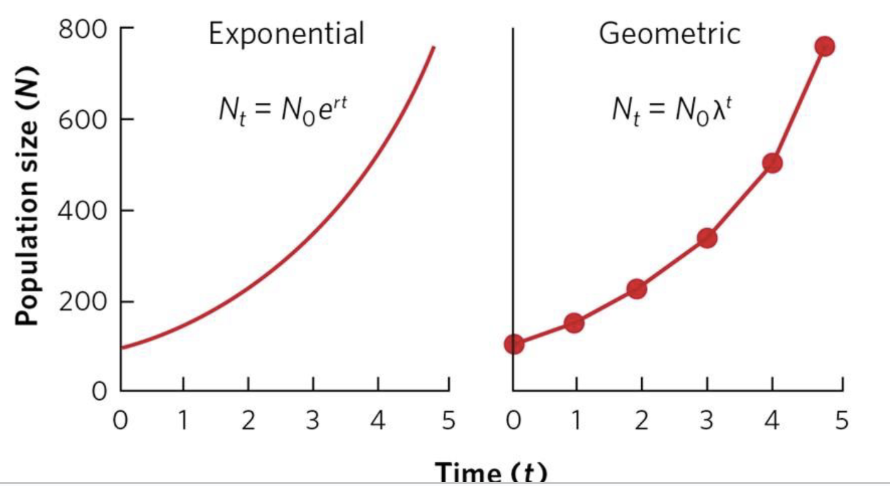
Comparison of λ and r Values when Populations are Decreasing, Constant, or Increasing

Growth Limits
Population growth is restricted by factors like limited resources, competition, and predation
Density Independent
Factors limiting population size regardless of the population’s density
Ex. Weather, natural disaster
Ex. Apple Thrips (red line = estimate- models change well)
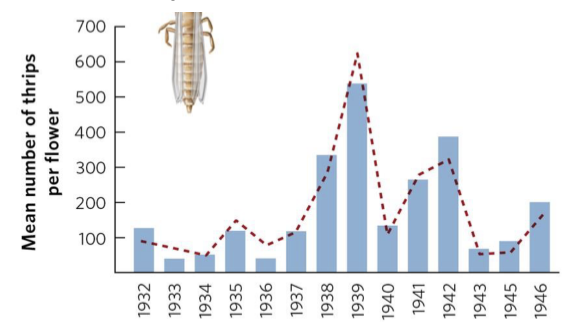
Density Dependent
Factors that affect population size in relation to the population’s density
Negative Density Dependence
When the rate of population growth decreases as population density increases
Ex. Transmissible disease, parasites, competition
Ex. Sea Birds
Live on islands
Growth starts exponentially → levels out → too many birds on island → some leave and colonize new island → repeat
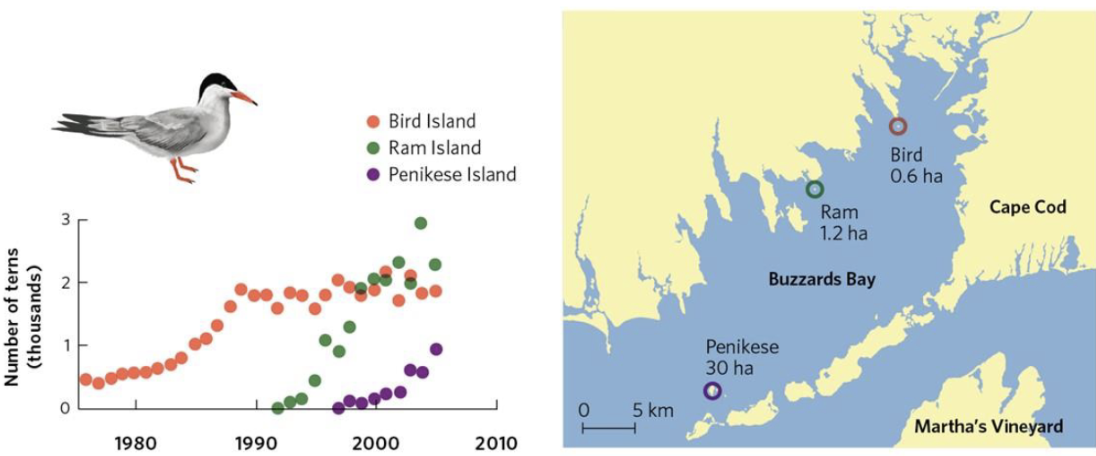
Self-Thinning Curve
Graphical relationship that shows how decreases in population density over time lead to increases in the mass of each individual in the population
Specific example of negative density dependence
When space becomes a limiting resource and plants start thinning
Ex. Artificially done by farmers
Plant lots of seeds to account for those that don’t take → need more space → select best plants → remove others to give space to best plants
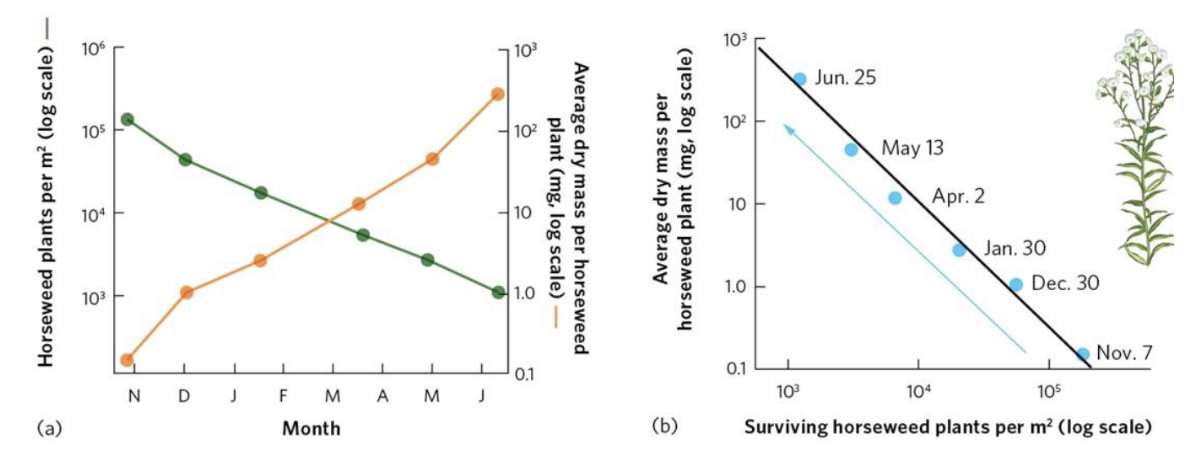
Positive Density Dependence
When the rate of population growth increases as population density increases
Most commonly seen at the beginning of a population before resources become limited
More individuals = more breeding
Ex. Cowslip Plants
Many plants pollinated by wind or animals can better attract these pollinators in groups
Dense patch of flower more likely to get pollinated than lone flower

Positive and Negative Density Dependence
Most populations are governed by both
Ex. Herring (right)
As population size increases, ratio of young to adult increases
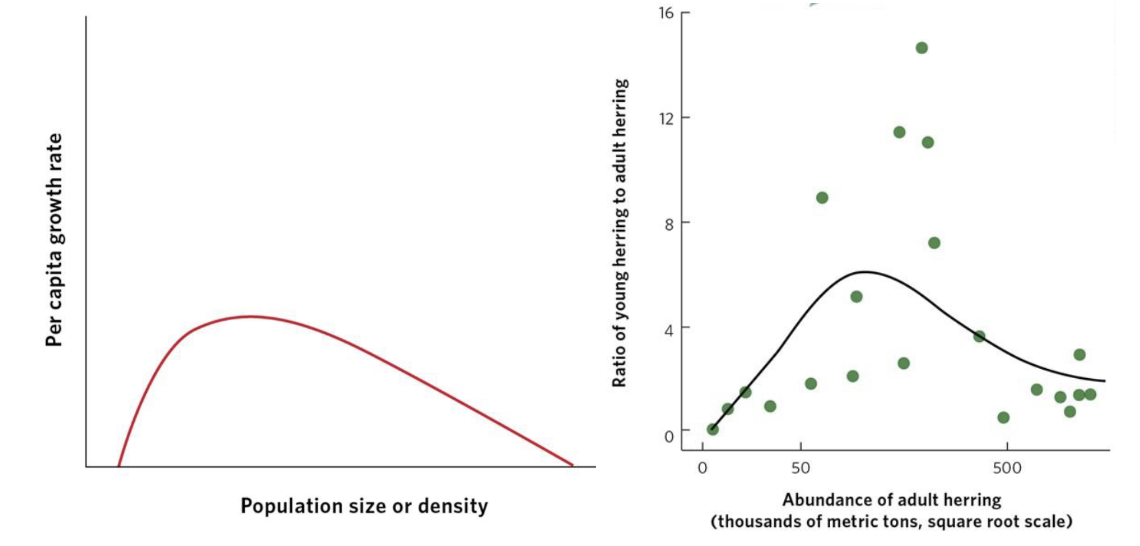
Carrying Capacity (K)
Maximum population size that can be supported by the environment
Can change depending on context
Logistic Growth Model
Growth model that describes slowing growth of populations at high densities

Inflection Point
Point of fastest growth after which growth begins to slow
Shift from increasing growth rate to decreasing growth rate
Point of sigmoidal growth curve at which the population achieves its highest growth rate
Steepest slope = highest growth rate of population
Example of Logistic Growth Model
Ex. Paramecium (right)
Manipulated amount of food available
Showed depending on environment, carrying capacity changed
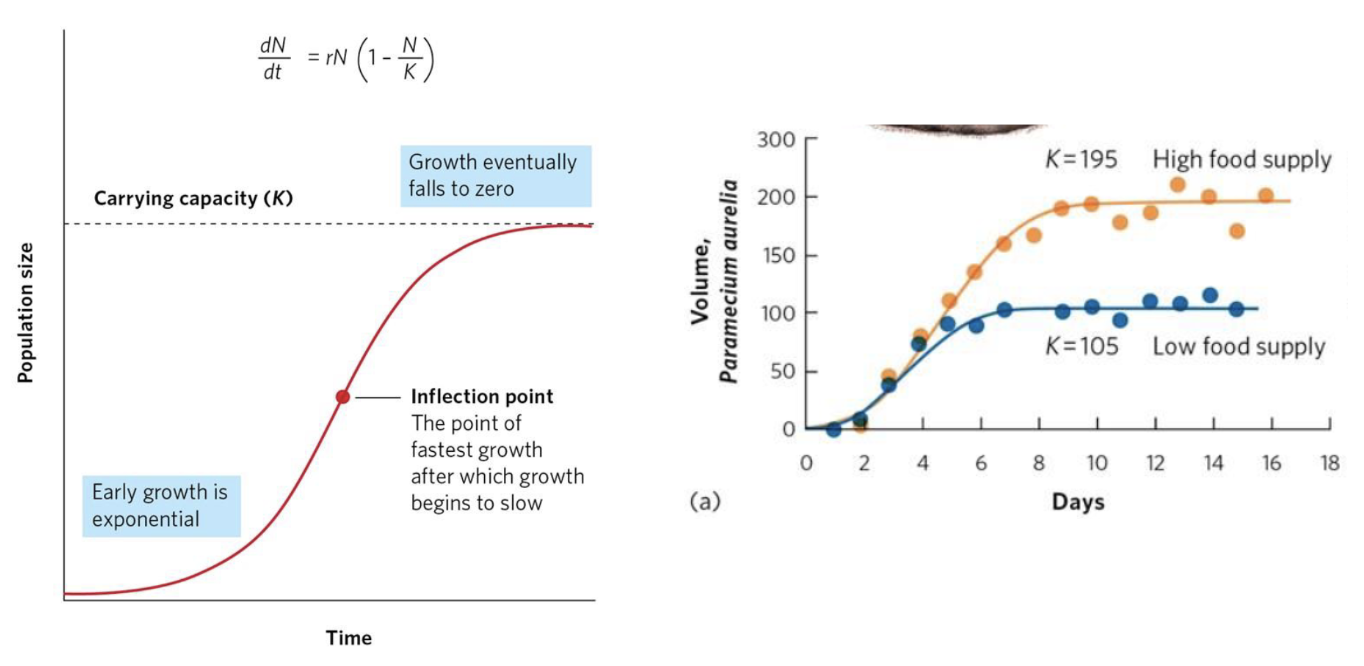
Age Structure
In a population, the proportion of individuals that occurs in different age classes
Gives an instant picture of what a current population looks like and what the future population will look like based off shape of tables
Wide base = growth
Same width throughout = stable
Skinny base/top heavy = decline

Life Tables
Tables that contain class-specific survival and fecundity (reproductive rate) data
Demonstrate the effects of age, size, and life history stage on population growth
Not visually friendly but allow for math
Ex. 100 total individuals divided into 4 age classes (don’t always correspond to years, but do in this ex)
x = age
s = survival rate
b = fecundity
Read as 0 (newborns), 50% survive, none reproduce
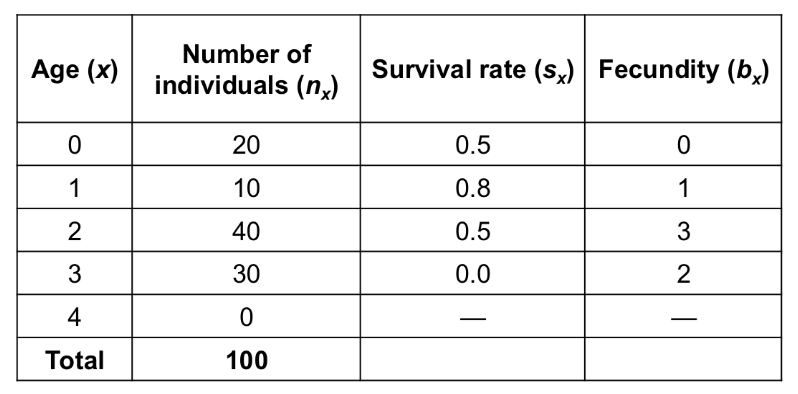
Predictions from Life Tables
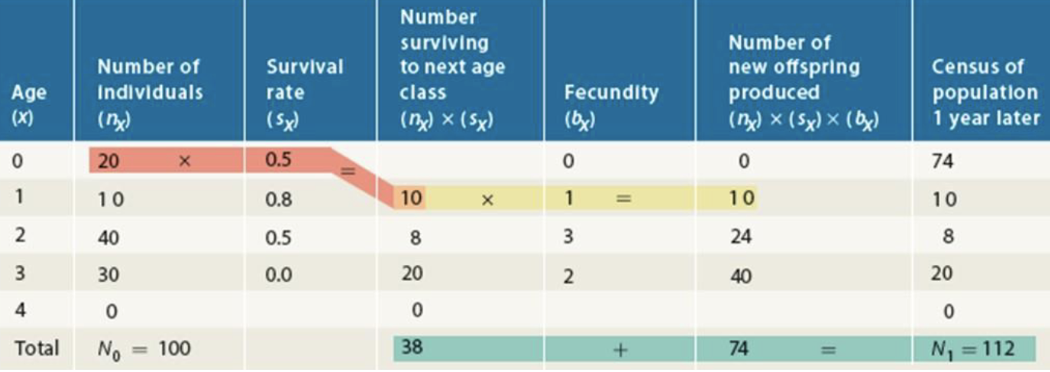
Survivorship (lx)
Probability that an individuals survive from birth to a specified age class
lx = sx-1 lx-1
l = lowercase L
Different from survival rate
Survival rate is the probability of an individual to survive to next age class
Survivorship is probability of an individual to survive from birth to specified age class
Survivorship for newborns is always equal to 1
Survivorship of newborns is the probability of newborn to survive to newborn age class (they already have)
Ex. l2 = (0.8)(0.5)
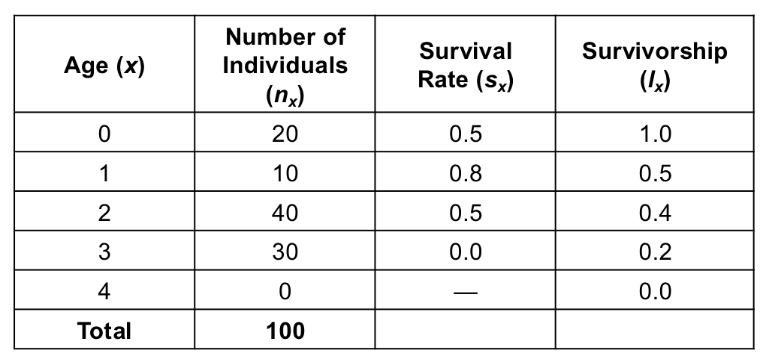
Survivorship Curves
Type 1- long lifespan
Parental care- more likely for offspring to survive
More k-selected species
Type 2- same probability through lifespan
Type 3- low chance of surviving until adulthood but likely to survive if they reach adulthood
No parental care- have more babies to compensate for those that die
More r-selected species
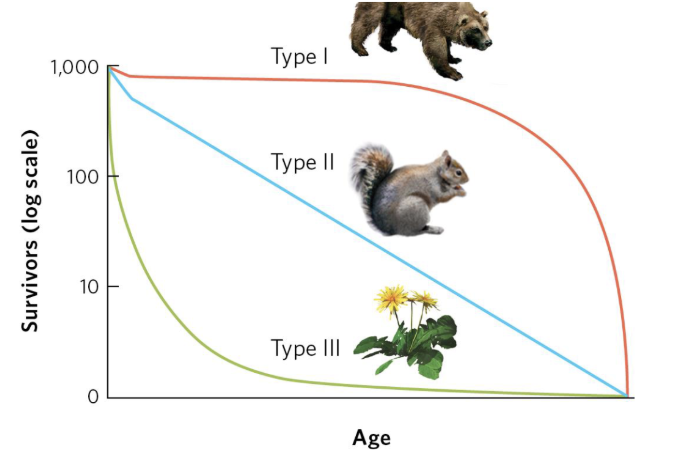
Net Reproductive Rate (R0)
Total number of female offspring that we expect an average female to produce over the course of her life
R0 = Σ lx bx
R0 = (l1 b1) + (l2 b2) + (l3 b3) + …
Expect population to be growing when R0 greater than 2 because parents are both replaced by more offspring
Ex. R0 = Σ lx bx = 2.1
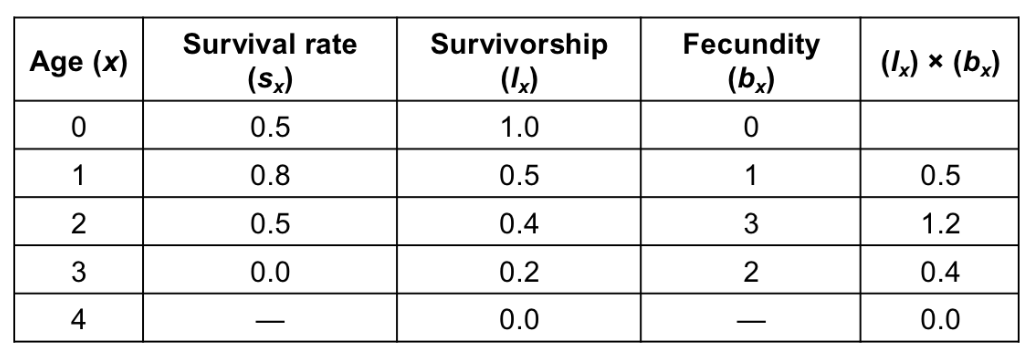
Generation Time (T)
The average time between the birth of an individual and the birth of its offspring

Cohort Life Table
Life table that follows a group of individuals born at the same time from birth to the death of the last individual
Static Life Table
Life table that quantifies the survival and fecundity of all individuals in a population during a single time interval
Snapshot in time